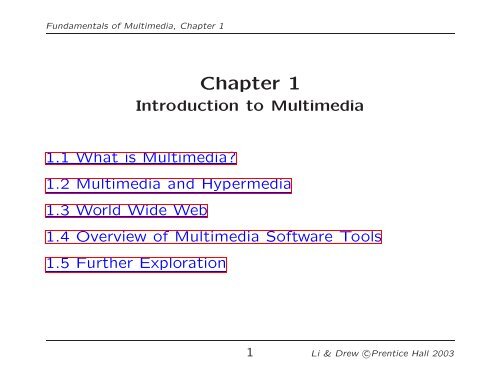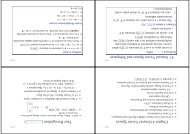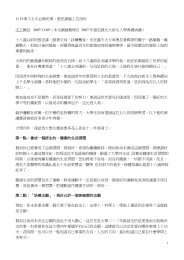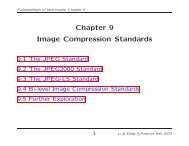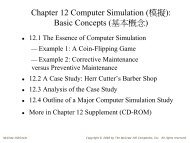Fundamentals of Multimedia, Chapter 1
Fundamentals of Multimedia, Chapter 1
Fundamentals of Multimedia, Chapter 1
You also want an ePaper? Increase the reach of your titles
YUMPU automatically turns print PDFs into web optimized ePapers that Google loves.
<strong>Fundamentals</strong> <strong>of</strong> <strong>Multimedia</strong>, <strong>Chapter</strong> 1<strong>Chapter</strong> 1Introduction to <strong>Multimedia</strong>1.1 What is <strong>Multimedia</strong>?1.2 <strong>Multimedia</strong> and Hypermedia1.3 World Wide Web1.4 Overview <strong>of</strong> <strong>Multimedia</strong> S<strong>of</strong>tware Tools1.5 Further Exploration1 Li & Drew c○Prentice Hall 2003
<strong>Fundamentals</strong> <strong>of</strong> <strong>Multimedia</strong>, <strong>Chapter</strong> 11.1 What is <strong>Multimedia</strong>?• When different people mention the term multimedia, they<strong>of</strong>ten have quite different, or even opposing, viewpoints.– A PC vendor: a PC that has sound capability, a DVD-ROM drive,and perhaps the superiority <strong>of</strong> multimedia-enabled microprocessorsthat understand additional multimedia instructions.– A consumer entertainment vendor: interactive cable TV with hundreds<strong>of</strong> digital channels available, or a cable TV-like service deliveredover a high-speed Internet connection.– A Computer Science (CS) student: applications that use multiplemodalities, including text, images, drawings (graphics), animation,video, sound including speech, and interactivity.• <strong>Multimedia</strong> and Computer Science:– Graphics, HCI, visualization, computer vision, data compression, graphtheory, networking, database systems.2 Li & Drew c○Prentice Hall 2003
<strong>Fundamentals</strong> <strong>of</strong> <strong>Multimedia</strong>, <strong>Chapter</strong> 1Components <strong>of</strong> <strong>Multimedia</strong>• <strong>Multimedia</strong> involves multiple modalities <strong>of</strong> text, audio, images,drawings, animation, and video. Examples <strong>of</strong> how thesemodalities are put to use:1. Video teleconferencing.2. Distributed lectures for higher education.3. Tele-medicine.4. Co-operative work environments.5. Searching in (very) large video and image databases fortarget visual objects.6. “Augmented” reality: placing real-appearing computergraphics and video objects into scenes.3 Li & Drew c○Prentice Hall 2003
<strong>Fundamentals</strong> <strong>of</strong> <strong>Multimedia</strong>, <strong>Chapter</strong> 17. Including audio cues for where video-conference participantsare located.8. Building searchable features into new video, and enablingvery high- to very low-bit-rate use <strong>of</strong> new, scalable multimediaproducts.9. Making multimedia components editable.10. Building “inverse-Hollywood” applications that can recreatethe process by which a video was made.11. Using voice-recognition to build an interactive environment,say a kitchen-wall web browser.4 Li & Drew c○Prentice Hall 2003
<strong>Fundamentals</strong> <strong>of</strong> <strong>Multimedia</strong>, <strong>Chapter</strong> 1<strong>Multimedia</strong> Research Topics and Projects• To the computer science researcher, multimedia consists <strong>of</strong>a wide variety <strong>of</strong> topics:1. <strong>Multimedia</strong> processing and coding: multimedia contentanalysis, content-based multimedia retrieval, multimediasecurity, audio/image/video processing, compression, etc.2. <strong>Multimedia</strong> system support and networking: networkprotocols, Internet, operating systems, servers and clients,quality <strong>of</strong> service (QoS), and databases.3. <strong>Multimedia</strong> tools, end-systems and applications: hypermediasystems, user interfaces, authoring systems.4. Multi-modal interaction and integration: “ubiquity”— web-everywhere devices, multimedia education includingComputer Supported Collaborative Learning, and designand applications <strong>of</strong> virtual environments.5 Li & Drew c○Prentice Hall 2003
<strong>Fundamentals</strong> <strong>of</strong> <strong>Multimedia</strong>, <strong>Chapter</strong> 11.2 <strong>Multimedia</strong> and Hypermedia• History <strong>of</strong> <strong>Multimedia</strong>:1. Newspaper: perhaps the first mass communication medium,uses text, graphics, and images.2. Motion pictures: conceived <strong>of</strong> in 1830’s in order to observemotion too rapid for perception by the human eye.3. Wireless radio transmission: Guglielmo Marconi, at Pontecchio,Italy, in 1895.4. Television: the new medium for the 20th century, establishedvideo as a commonly available medium and hassince changed the world <strong>of</strong> mass communications.8 Li & Drew c○Prentice Hall 2003
<strong>Fundamentals</strong> <strong>of</strong> <strong>Multimedia</strong>, <strong>Chapter</strong> 15. The connection between computers and ideas aboutmultimedia covers what is actually only a short period:1945 – Vannevar Bush wrote a landmark article describing what amountsto a hypermedia system called Memex.−→ Link to full V. Bush 1945 Memex article, “As We May Think”1960 – Ted Nelson coined the term hypertext.1967 – Nicholas Negroponte formed the Architecture Machine Group.1968 – Douglas Engelbart demonstrated the On-Line System (NLS), anothervery early hypertext program.1969 – Nelson and van Dam at Brown University created an early hypertexteditor called FRESS.1976 – The MIT Architecture Machine Group proposed a project entitledMultiple Media — resulted in the Aspen Movie Map, the firsthypermedia videodisk, in 1978.9 Li & Drew c○Prentice Hall 2003
<strong>Fundamentals</strong> <strong>of</strong> <strong>Multimedia</strong>, <strong>Chapter</strong> 11985 – Negroponte and Wiesner co-founded the MIT Media Lab.1989 – Tim Berners-Lee proposed the World Wide Web1990 – Kristina Hooper Woolsey headed the Apple <strong>Multimedia</strong> Lab.1991 – MPEG-1 was approved as an international standard for digitalvideo — led to the newer standards, MPEG-2, MPEG-4, andfurther MPEGs in the 1990s.1991 – The introduction <strong>of</strong> PDAs in 1991 began a new period in the use<strong>of</strong> computers in multimedia.1992 – JPEG was accepted as the international standard for digital imagecompression — led to the new JPEG2000 standard.1992 – The first MBone audio multicast on the Net was made.1993 – The University <strong>of</strong> Illinois National Center for Supercomputing Applicationsproduced NCSA Mosaic — the first full-fledged browser.10 Li & Drew c○Prentice Hall 2003
<strong>Fundamentals</strong> <strong>of</strong> <strong>Multimedia</strong>, <strong>Chapter</strong> 11994 – Jim Clark and Marc Andreessen created the Netscape program.1995 – The JAVA language was created for platform-independent applicationdevelopment.1996 – DVD video was introduced; high quality full-length movies weredistributed on a single disk.1998 – XML 1.0 was announced as a W3C Recommendation.1998 – Hand-held MP3 devices first made inroads into consumerist tastesin the fall <strong>of</strong> 1998, with the introduction <strong>of</strong> devices holding 32MB<strong>of</strong> flash memory.2000 – WWW size was estimated at over 1 billion pages.11 Li & Drew c○Prentice Hall 2003
<strong>Fundamentals</strong> <strong>of</strong> <strong>Multimedia</strong>, <strong>Chapter</strong> 1Hypermedia and <strong>Multimedia</strong>• A hypertext system: meant to be read nonlinearly, by followinglinks that point to other parts <strong>of</strong> the document, or toother documents (Fig. 1.1)• HyperMedia: not constrained to be text-based, can includeother media, e.g., graphics, images, and especially the continuousmedia — sound and video.– The World Wide Web (WWW) — the best example <strong>of</strong> ahypermedia application.• <strong>Multimedia</strong> means that computer information can be representedthrough audio, graphics, images, video, and animationin addition to traditional media.12 Li & Drew c○Prentice Hall 2003
<strong>Fundamentals</strong> <strong>of</strong> <strong>Multimedia</strong>, <strong>Chapter</strong> 1HypertextNormal TextLinear"Hot spots"NonlinearFig 1.1: Hypertext is nonlinear13 Li & Drew c○Prentice Hall 2003
<strong>Fundamentals</strong> <strong>of</strong> <strong>Multimedia</strong>, <strong>Chapter</strong> 1• Examples <strong>of</strong> typical present multimedia applications include:– Digital video editing and production systems.– Electronic newspapers/magazines.– World Wide Web.– On-line reference works: e.g. encyclopedias, games, etc.– Home shopping.– Interactive TV.– <strong>Multimedia</strong> courseware.– Video conferencing.– Video-on-demand.– Interactive movies.14 Li & Drew c○Prentice Hall 2003
<strong>Fundamentals</strong> <strong>of</strong> <strong>Multimedia</strong>, <strong>Chapter</strong> 11.3 World Wide Web• The W3C has listed the following goals for the WWW:1. Universal access <strong>of</strong> web resources (by everyone everywhere).2. Effectiveness <strong>of</strong> navigating available information.3. Responsible use <strong>of</strong> posted material.• History <strong>of</strong> the WWW1960s- Charles Goldfarb et al. developed the GeneralizedMarkup Language (GML) forIBM.1986 – The ISO released a final version <strong>of</strong> the Standard GeneralizedMarkup Language (SGML).15 Li & Drew c○Prentice Hall 2003
<strong>Fundamentals</strong> <strong>of</strong> <strong>Multimedia</strong>, <strong>Chapter</strong> 11990 – Tim Berners-Lee invented the HyperText MarkupLanguage (HTML), and the HyperText Transfer Protocol(HTTP).1993 – NCSA released an alpha version <strong>of</strong> Mosaic based onthe version by Marc Andreessen for X-Windows —the first popular browser.1994 – Marc Andreessen et al. formed Mosaic CommunicationsCorporation — later the Netscape CommunicationsCorporation.1998 – The W3C accepted XML version 1.0 specificationsas a Recommendation — the main focus <strong>of</strong> the W3Cand supersedes HTML.16 Li & Drew c○Prentice Hall 2003
<strong>Fundamentals</strong> <strong>of</strong> <strong>Multimedia</strong>, <strong>Chapter</strong> 1HTTP (HyperText Transfer Protocol)• HTTP: a protocol that was originally designed for transmittinghypermedia, but can also support the transmission <strong>of</strong>any file type.no infor-• HTTP is a stateless request/response protocol:mation carried over for the next request.• The basic request format:Method URI VersionAdditional-Headers:Message-body• The URI (Uniform Resource Identifier): an identifier for theresource accessed, e.g. the host name, always preceded bythe token “http://”.17 Li & Drew c○Prentice Hall 2003
<strong>Fundamentals</strong> <strong>of</strong> <strong>Multimedia</strong>, <strong>Chapter</strong> 1• Two popular methods: GET and POST.• The basic response format:Version Status-Code Status-PhraseAdditional-HeadersMessage-body• Two commonly seen status codes:1. 200 OK — the request was processed successfully.2. 404 Not Found — the URI does not exist.18 Li & Drew c○Prentice Hall 2003
<strong>Fundamentals</strong> <strong>of</strong> <strong>Multimedia</strong>, <strong>Chapter</strong> 1HTML (HyperText Markup Language)• HTML: a language for publishing Hypermedia on the WorldWide Web — defined using SGML:1. HTML uses ASCII, it is portable to all different (possiblybinary incompatible) computer hardware.2. The current version <strong>of</strong> HTML is version 4.01.3. The next generation <strong>of</strong> HTML is XHTML — a reformulation<strong>of</strong> HTML using XML.• HTML uses tags to describe document elements:– — defining a starting point,– — the ending point <strong>of</strong> the element.– Some elements have no ending tags.19 Li & Drew c○Prentice Hall 2003
<strong>Fundamentals</strong> <strong>of</strong> <strong>Multimedia</strong>, <strong>Chapter</strong> 1• A very simple HTML page is as follows: A sample web page. We can put any text we like here, since this isa paragraph element. • Naturally, HTML has more complex structures and can bemixed in with other standards.20 Li & Drew c○Prentice Hall 2003
<strong>Fundamentals</strong> <strong>of</strong> <strong>Multimedia</strong>, <strong>Chapter</strong> 1XML (Extensible Markup Language)• XML: a markup language for the WWW in which there ismodularity <strong>of</strong> data, structure and view so that user or applicationcan be able to define the tags (structure).• Example <strong>of</strong> using XML to retrieve stock information from adatabase according to a user query:1. First use a global Document Type Definition (DTD) thatis already defined.2. The server side script will abide by the DTD rules togenerate an XML document according to the query usingdata from your database.3. Finally send user the XML Style Sheet (XSL) dependingon the type <strong>of</strong> device used to display the information.21 Li & Drew c○Prentice Hall 2003
<strong>Fundamentals</strong> <strong>of</strong> <strong>Multimedia</strong>, <strong>Chapter</strong> 1• The current XML version is XML 1.0, approved by the W3Cin Feb. 1998.• XML syntax looks like HTML syntax, although it is muchmore strict:– All tags are in lower case, and a tag that has only inlinedata has to terminate itself, i.e., .– Uses name spaces so that multiple DTDs declaring differentelements but with similar tag names can have theirelements distinguished.– DTDs can be imported from URIs as well.22 Li & Drew c○Prentice Hall 2003
<strong>Fundamentals</strong> <strong>of</strong> <strong>Multimedia</strong>, <strong>Chapter</strong> 1• An example <strong>of</strong> an XML document structure — the definitionfor a small XHTML document: ... [html that followsthe above mentionedXML rules]23 Li & Drew c○Prentice Hall 2003
<strong>Fundamentals</strong> <strong>of</strong> <strong>Multimedia</strong>, <strong>Chapter</strong> 1• The following XML related specifications are also standardized:– XML Protocol: used to exchange XML information betweenprocesses.–XMLSchema: a more structured and powerful languagefor defining XML data types (tags).–XSL: basically CSS for XML.–SMIL: synchronized <strong>Multimedia</strong> Integration Language, pronounced“smile” — a particular application <strong>of</strong> XML (globallypredefined DTD) that allows for specification <strong>of</strong> interactionamong any media types and user input, in atemporally scripted manner.24 Li & Drew c○Prentice Hall 2003
<strong>Fundamentals</strong> <strong>of</strong> <strong>Multimedia</strong>, <strong>Chapter</strong> 1SMIL (Synchronized <strong>Multimedia</strong> IntegrationLanguage)• Purpose <strong>of</strong> SMIL: it is also desirable to be able to publishmultimedia presentations using a markup language.• A multimedia markup language needs to enable schedulingand synchronization <strong>of</strong> different multimedia elements, anddefine their interactivity with the user.• The W3C established a Working Group in 1997 to come upwith specifications for a multimedia synchronization language— SMIL 2.0 was accepted in August 2001.• SMIL 2.0 is specified in XML using a modularization approachsimilar to the one used in xhtml:25 Li & Drew c○Prentice Hall 2003
<strong>Fundamentals</strong> <strong>of</strong> <strong>Multimedia</strong>, <strong>Chapter</strong> 11. All SMIL elements are divided into modules — sets <strong>of</strong>XML elements, attributes and values that define one conceptualfunctionality.2. In the interest <strong>of</strong> modularization, not all available modulesneed to be included for all applications.3. Language Pr<strong>of</strong>iles: specifies a particular grouping <strong>of</strong>modules, and particular modules may have integration requirementsthat a pr<strong>of</strong>ile must follow.– SMIL 2.0 has a main language pr<strong>of</strong>ile that includes almostall SMIL modules.• Basic elements <strong>of</strong> SMIL as shown in the following example:26 Li & Drew c○Prentice Hall 2003
<strong>Fundamentals</strong> <strong>of</strong> <strong>Multimedia</strong>, <strong>Chapter</strong> 127 Li & Drew c○Prentice Hall 2003
<strong>Fundamentals</strong> <strong>of</strong> <strong>Multimedia</strong>, <strong>Chapter</strong> 11.4 Overview <strong>of</strong> <strong>Multimedia</strong> S<strong>of</strong>tware Tools• The categories <strong>of</strong> s<strong>of</strong>tware tools briefly examined here are:1. Music Sequencing and Notation2. Digital Audio3. Graphics and Image Editing4. Video Editing5. Animation6. <strong>Multimedia</strong> Authoring28 Li & Drew c○Prentice Hall 2003
<strong>Fundamentals</strong> <strong>of</strong> <strong>Multimedia</strong>, <strong>Chapter</strong> 1Music Sequencing and Notation• Cakewalk: now called Pro Audio.– The term sequencer comes from older devices that storedsequences <strong>of</strong> notes (“events”, in MIDI).– It is also possible to insert WAV files and Windows MCIcommands (for animation and video) into music tracks(MCI is a ubiquitous component <strong>of</strong> the Windows API.)• Cubase: another sequencing/editing program, with capabilitiessimilar to those <strong>of</strong> Cakewalk. It includes some digitalaudio editing tools.• Macromedia Soundedit: mature program for creating audi<strong>of</strong>or multimedia projects and the web that integrates wellwith other Macromedia products such as Flash and Director.29 Li & Drew c○Prentice Hall 2003
<strong>Fundamentals</strong> <strong>of</strong> <strong>Multimedia</strong>, <strong>Chapter</strong> 1Digital Audio• Digital Audio tools deal with accessing and editing the actualsampled sounds that make up audio:–Cool Edit: a very powerful and popular digital audiotoolkit; emulates a pr<strong>of</strong>essional audio studio — multitrackproductions and sound file editing including digital signalprocessing effects.– Sound Forge: a sophisticated PC-based program forediting audio WAV files.–ProTools: a high-end integrated audio production andediting environment — MIDI creation and manipulation;powerful audio mixing, recording, and editing s<strong>of</strong>tware.30 Li & Drew c○Prentice Hall 2003
<strong>Fundamentals</strong> <strong>of</strong> <strong>Multimedia</strong>, <strong>Chapter</strong> 1Graphics and Image Editing• Adobe Illustrator: a powerful publishing tool from Adobe.Uses vector graphics; graphics can be exported to Web.• Adobe Photoshop: the standard in a graphics, image processingand manipulation tool.– Allows layers <strong>of</strong> images, graphics, and text that can be separatelymanipulated for maximum flexibility.– Filter factory permits creation <strong>of</strong> sophisticated lighting-effects filters.• Macromedia Fireworks: s<strong>of</strong>tware for making graphics specificallyfor the web.• Macromedia Freehand: a text and web graphics editingtool that supports many bitmap formats such as GIF, PNG,and JPEG.31 Li & Drew c○Prentice Hall 2003
<strong>Fundamentals</strong> <strong>of</strong> <strong>Multimedia</strong>, <strong>Chapter</strong> 1Video Editing• Adobe Premiere: an intuitive, simple video editing tool fornonlinear editing, i.e., putting video clips into any order:– Video and audio are arranged in “tracks”.– Provides a large number <strong>of</strong> video and audio tracks, superimpositionsand virtual clips.– A large library <strong>of</strong> built-in transitions, filters and motionsfor clips ⇒ effective multimedia productions with littleeffort.• Adobe After Effects: a powerful video editing tool thatenables users to add and change existing movies. Can addmany effects: lighting, shadows, motion blurring; layers.• Final Cut Pro:only.a video editing tool by Apple; Macintosh32 Li & Drew c○Prentice Hall 2003
<strong>Fundamentals</strong> <strong>of</strong> <strong>Multimedia</strong>, <strong>Chapter</strong> 1Animation• <strong>Multimedia</strong> APIs:– Java3D: API used by Java to construct and render 3Dgraphics, similar to the way in which the Java MediaFramework is used for handling media files.1. Provides a basic set <strong>of</strong> object primitives (cube, splines,etc.) for building scenes.2. It is an abstraction layer built on top <strong>of</strong> OpenGL orDirectX (the user can select which).– DirectX : Windows API that supports video, images, audioand 3-D animation– OpenGL: the highly portable, most popular 3-D API.33 Li & Drew c○Prentice Hall 2003
<strong>Fundamentals</strong> <strong>of</strong> <strong>Multimedia</strong>, <strong>Chapter</strong> 1• Rendering Tools:– 3D Studio Max: rendering tool that includes a number <strong>of</strong>very high-end pr<strong>of</strong>essional tools for character animation,game development, and visual effects production.– S<strong>of</strong>timage XSI: a powerful modeling, animation, and renderingpackage used for animation and special effects infilms and games.– Maya: competing product to S<strong>of</strong>timage; as well, it is acomplete modeling package.– RenderMan: rendering package created by Pixar.• GIF Animation Packages: a simpler approach to animation,allows very quick development <strong>of</strong> effective small animationsfor the web.34 Li & Drew c○Prentice Hall 2003
<strong>Fundamentals</strong> <strong>of</strong> <strong>Multimedia</strong>, <strong>Chapter</strong> 1<strong>Multimedia</strong> Authoring• Macromedia Flash: allows users to create interactive moviesby using the score metaphor, i.e., a timeline arranged in parallelevent sequences.• Macromedia Director: uses a movie metaphor to create interactivepresentations — very powerful and includes a builtinscripting language, Lingo, that allows creation <strong>of</strong> complexinteractive movies.• Authorware: a mature, well-supported authoring productbased on the Iconic/Flow-control metaphor.• Quest: similar to Authorware in many ways, uses a type<strong>of</strong> flowcharting metaphor. However, the flowchart nodescan encapsulate information in a more abstract way (calledframes) than simply subroutine levels.35 Li & Drew c○Prentice Hall 2003
<strong>Fundamentals</strong> <strong>of</strong> <strong>Multimedia</strong>, <strong>Chapter</strong> 11.5 Further Exploration−→ Link to Further Exploration for <strong>Chapter</strong> 1.• In <strong>Chapter</strong> 1 <strong>of</strong> the Further Exploration directory, the websiteprovides links to much <strong>of</strong> the history <strong>of</strong> multimedia.• Other links in the text website include information on:– Ted Nelson and the Xanadu project.– Nicholas Negroponte’s work at the MIT Media Lab.– Douglas Engelbart, and the history <strong>of</strong> the “On-Line System”.– The MIT Media Lab– Client-side execution.36 Li & Drew c○Prentice Hall 2003


